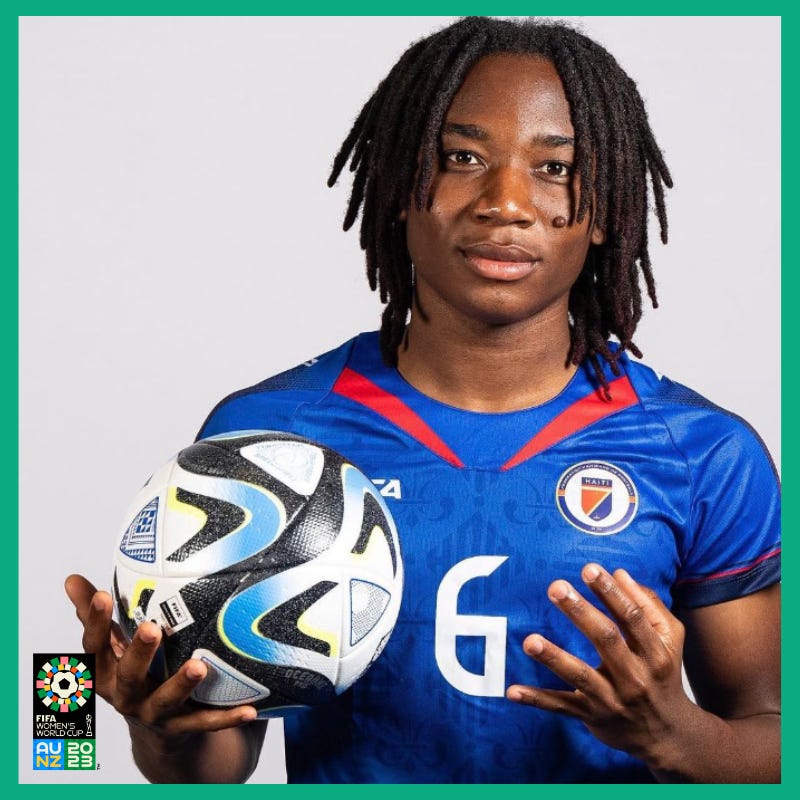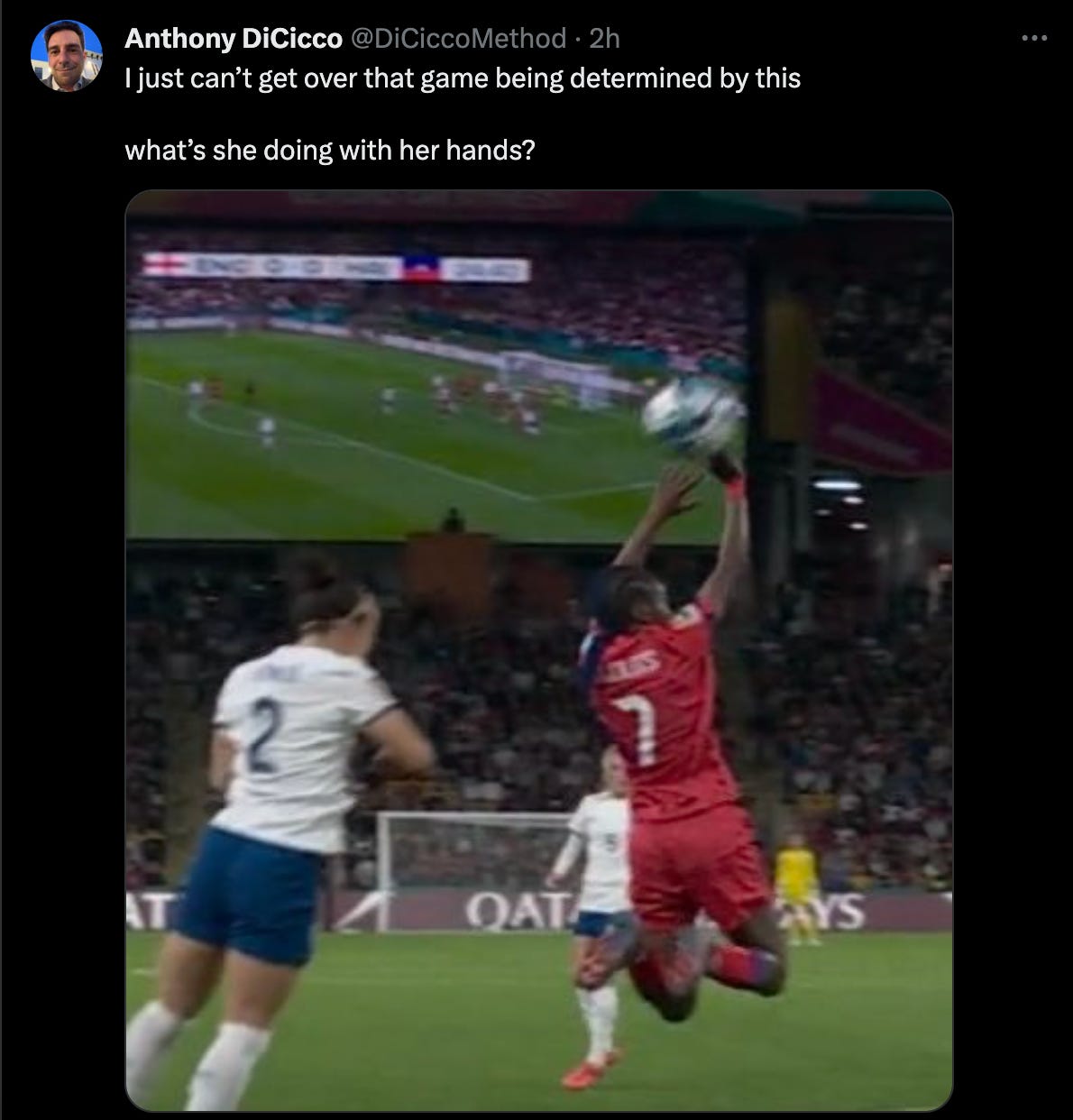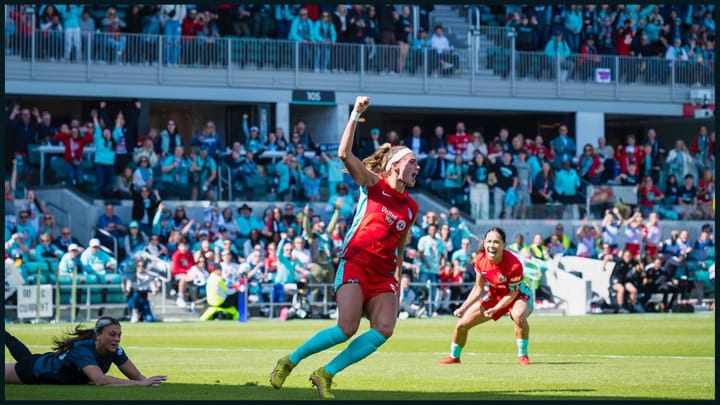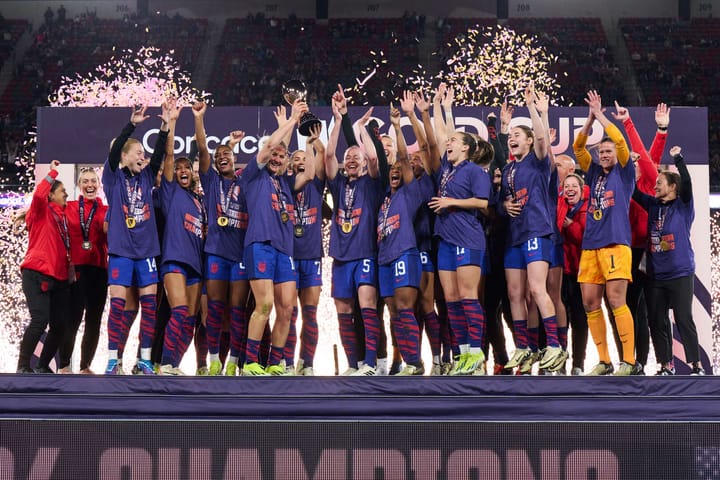Madmwazèl Two-Way: Melchie Dumornay dazzling and relentless on World Cup debut
The Haitian forward was everywhere as her country narrowly lost to England 1-0 in their opening match of the 2023 World Cup.
Ever since I started watching American basketball somewhat consistently in the 2010s, there has been a phrase that sort of irked me (just a little little bit).
The nomenclature is: “They are a two-way player.” It refers to a player who excels in the attack and when in defence. Essentially, with the ball or without the ball, they’re terrific in every phase.
The reason it didn’t always click for me is because I just kept thinking, all of these players can’t have got here by sacking off the defensive side of things, right?
It’s a tremendously fluid sport. Even the least specialized defensive player has to be a two-way player. Most of the basketball I was watching was in the NBA, WNBA, or NCAA. Quite often the very best athletes in that sport in the world.
My opinion was that they are all two-way players just some are better two-way players, maybe more equipped to play the position.
At New Orleans Pelicans matches, in 2017, I would hear fans praise guard Jrue Holiday by shouting “Mr. Two-Way” as he would walk onto the court or hustle back after turnovers. The nickname did grow on me, but the moniker still felt vague.
Especially in the frenetic contemporary game of basketball. Where the play is end-to-end and players have to consistently switch their intent in confined spaces on crowded courts.
Maybe they should be called “Everywhere players” instead?

The dueling Dumornay
On Saturday, Haiti’s Melchie Dumornay put in such an exhilarating defensive attacking performance in a 1-0 World Cup group stage loss to England that I was so vividly reminded of the “Two-Way player” moniker.
Football (soccer) like basketball requires most, if not all, players to be “Two-way players”. Talk to any coach nowadays and they’ll talk about “360 defending”.
But the Haiti forward really was everywhere. A needle in the English midfield’s side. Buzzing around Kiera Walsh, Georgia Stanway, and Ella Toone like a mosquito in the middle of the night. She could still be pestering them right now back at the hotel in Brisbane. We just don’t know.
The 19-year-old finished the match with an outrageous 20 ground duels, of which she won an impressive 11 (55%). Both totals were more than any other on the pitch.
Haiti finished the match with a total of 58, which meant she had 34% of her nation’s ground duels on the day. Dumornay also had one successful tackle, one interception, seven recoveries and only once allowed an England player to dribble past her.
While Haiti didn’t commit too much to the high press (just 1% of their off-ball actions per FIFA stats), Dumornay’s zippy presence did enough to destabilize England’s backline throughout the 90 minutes too.
In the first minute, two sloppy passes by Millie Bright and Lauren Hemp inside the England defensive third resulted in turnovers and set the uncomfortable tone for the Lionesses.
Moments later Dumornay attempted an audacious bicycle kick. While it didn’t connect, it served as an explicit reminder of her star power and belief in the opposition box.
For all the spark that Haiti opened with, a rogue leap, with both hands raised above her head, by defender Batchecha Louis resulted in a penalty kick and gave England its advantage.

Stanway converted on the second attempt after Kerly Theus had saved the initial attempt but been a yard off of her line. A spectacular World Cup moment that will forever be lost in the correctly officiated VAR twilight zone.
By halftime England looked passive. The match was playing out on Haiti’s terms. These were Dumornay’s roads, and England couldn’t match her physically, or grasp the occasion in the same way. She was exhibiting a laser-like focus on the Brisbane grass.

Everywhere, all at once
When Haiti did get on the ball, Dumornay stayed electric. The Caribbeans were prepared to play on the ground and in-behind the Europeans the minute they won the ball, especially in transition.
The Olympique Lyon forward led her team in key passes with three, as well as passes into the final third with three.
In particular, it felt like Haiti and Dumornay targeted the space between the centrebacks and fullbacks. On the right-hand side of England’s defence, that meant the space between the recently injured Millie Bright and Lucy Bronze.
Neither looked comfortable coping with the speed, ball anticipation, and running lane vision that Dumornay showed either passing the ball or progressing the ball in that channel.
Of her 14 ball carries on the day, four were progressive, and three of those into the final third. In take-on situations, Dumornay got the better of her English counterpart five out of eight times.
In the second half, it really started to click. Bigger chances fell.
Haiti forced its first save when Dumornay stormed past Bronze and whizzed a stinging shot toward the goal from the very edge of the England box.
Curiously, most of Dumornay’s receptions came in the middle of the pitch. Her most effective passes went down Haiti’s left, while her most incisive dribbles came on the right wing.
Often it was around the halfway line that Dumornay would pick the ball and look to hit Nérilia Mondésir on the left wing of the Haiti attack.
Late on in the match, Mary Earps had the save of the day when Dumornay became the creator. Arguably the best open play chance (0.28 xG) for either side, Dumornay spotted Mondésir, with room to dash past both England centerbacks and into the box, and played her through.
Mondésir turned Jess Carter, who was trying to get back and recover, and softly laid the ball off to substitute Roseline Eloissaint.
Despite having only been introduced 90 seconds prior, Eloissaint remained poised when receiving the ball. Her first touch has the perfect weight. But the second touch, a side-footed shot on her right from 10-yards out, didn’t create enough of an angle to evade Earps’ outstretched leg.
Byenvini, Madmwazèl Two-Way
Basketball and football (soccer) can be a lot alike.
Both have jazz-like improvisations that arise from more traditional structures. There’s immense knowledge and understanding, plenty of preparation, and rehearsal. But, when performing, the biggest names are known for their freedom to explore.
At other times, it can be more about following the system. Hitting the right notes, at the time, at the right tempo, and with the right force.
To me, Dumornay was the perfect encapsulation of these musical and sporting themes. She was everywhere. She was in her element. Well drilled. Dictating the tempo. But entirely original too.
Emma Hayes said on the ITV broadcast of the match that Dumornay is destined to be one the best players in the world. And after two years of consistent hype we sort of already knew that.
Her recent big transfer to Olympique Lyon, and seasons devastating for Stade Reims in the D1 Arkema, had made the 19-year-old a timeline-hold name since before she could legally sip win in Paris.
But perhaps what we really learned from her World Cup debut was that she can be one of the best players in the world in every which way. Not just as an impactful forward, prone to making things happen on the break.
Two ways, maybe even three ways. The whole Dumornay shone bright and dazzled.
Byenvini, Madmwazèl Two-Way.




Comments ()